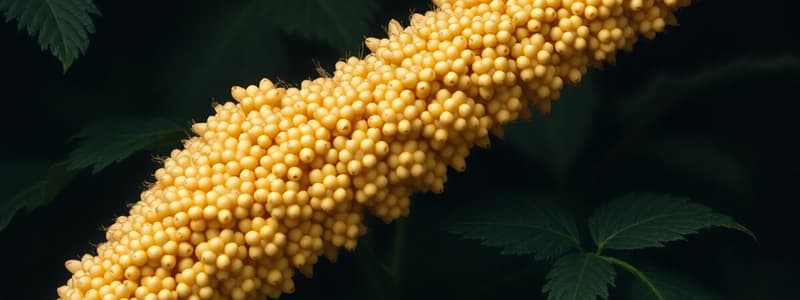Podcast
Questions and Answers
What role does sialic acid play in cancer cells?
What role does sialic acid play in cancer cells?
- It helps cancer cells store energy.
- It enhances the growth of cancer cells.
- It serves as a structural component in cancer cells.
- It signals that a cell is 'self' to the immune system. (correct)
Which carbohydrate serves a structural role in plants?
Which carbohydrate serves a structural role in plants?
- Cellulose (correct)
- Starch
- Glucose
- Fructose
What percentage of the human diet should ideally consist of carbohydrates by mass?
What percentage of the human diet should ideally consist of carbohydrates by mass?
- 50%
- 75%
- 40%
- 66% (correct)
How much energy does one gram of carbohydrate release when oxidized by cells?
How much energy does one gram of carbohydrate release when oxidized by cells?
In which form do plants primarily store carbohydrates as energy reserves?
In which form do plants primarily store carbohydrates as energy reserves?
What is the most abundant class of bioorganic molecules on Earth?
What is the most abundant class of bioorganic molecules on Earth?
What serves as the primary carbohydrate source for humans and animals?
What serves as the primary carbohydrate source for humans and animals?
What is the primary purpose of carbohydrate oxidation in humans?
What is the primary purpose of carbohydrate oxidation in humans?
What happens to sucrose when it is cooked with acid-containing foods?
What happens to sucrose when it is cooked with acid-containing foods?
Which of the following oligosaccharides cannot be digested by humans?
Which of the following oligosaccharides cannot be digested by humans?
What is the role of solanine in potatoes?
What is the role of solanine in potatoes?
Which blood type is considered a universal donor?
Which blood type is considered a universal donor?
What is the defining characteristic of a storage polysaccharide?
What is the defining characteristic of a storage polysaccharide?
What distinguishes a homopolysaccharide from a heteropolysaccharide?
What distinguishes a homopolysaccharide from a heteropolysaccharide?
How many monosaccharide units do oligosaccharides contain?
How many monosaccharide units do oligosaccharides contain?
What are the cyclic forms of monosaccharides primarily formed by?
What are the cyclic forms of monosaccharides primarily formed by?
What type of compounds are formed in the cyclic form of monosaccharides?
What type of compounds are formed in the cyclic form of monosaccharides?
What is the link between the two monosaccharides in disaccharides called?
What is the link between the two monosaccharides in disaccharides called?
Which disaccharide is known as malt sugar and is produced from starch breakdown?
Which disaccharide is known as malt sugar and is produced from starch breakdown?
What specific linkage occurs in maltose?
What specific linkage occurs in maltose?
What is needed for the hydrolysis of D-maltose to occur?
What is needed for the hydrolysis of D-maltose to occur?
Which enzyme is responsible for breaking the glucose-glucose linkage in maltose?
Which enzyme is responsible for breaking the glucose-glucose linkage in maltose?
What are disaccharides primarily characterized by?
What are disaccharides primarily characterized by?
Which of the following is NOT a common disaccharide seen in biological systems?
Which of the following is NOT a common disaccharide seen in biological systems?
What is the main reason specific disaccharides are produced in cells?
What is the main reason specific disaccharides are produced in cells?
Which description correctly identifies an aldose with three carbons?
Which description correctly identifies an aldose with three carbons?
What is the correct term for a ketose with six carbon atoms?
What is the correct term for a ketose with six carbon atoms?
Which of the following monosaccharides is considered chiral?
Which of the following monosaccharides is considered chiral?
Which sugar is recognized as the blood sugar and is also referred to as dextrose?
Which sugar is recognized as the blood sugar and is also referred to as dextrose?
D-Fructose is biochemically significant for which of the following reasons?
D-Fructose is biochemically significant for which of the following reasons?
What compound does D-Ribose primarily contribute to?
What compound does D-Ribose primarily contribute to?
Which sugar is often referred to as brain sugar due to its presence in glycoproteins found in brain and nerve tissue?
Which sugar is often referred to as brain sugar due to its presence in glycoproteins found in brain and nerve tissue?
Which monosaccharide is not typically found in its free form and is synthesized from glucose?
Which monosaccharide is not typically found in its free form and is synthesized from glucose?
Dihydroxyacetone is characterized by what notable property?
Dihydroxyacetone is characterized by what notable property?
Which of the following chemical formulas corresponds to a ketopentose?
Which of the following chemical formulas corresponds to a ketopentose?
Which of the following statements about carbohydrates is true?
Which of the following statements about carbohydrates is true?
What is the general empirical formula for most simple carbohydrates?
What is the general empirical formula for most simple carbohydrates?
Which carbohydrate type cannot be hydrolyzed into simpler units?
Which carbohydrate type cannot be hydrolyzed into simpler units?
What is produced when a disaccharide undergoes hydrolysis?
What is produced when a disaccharide undergoes hydrolysis?
What distinguishes oligosaccharides from monosaccharides and disaccharides?
What distinguishes oligosaccharides from monosaccharides and disaccharides?
Which statement is accurate about polysaccharides?
Which statement is accurate about polysaccharides?
Carbohydrates consist of which type of molecules?
Carbohydrates consist of which type of molecules?
How do carbohydrates contribute to cellular functions?
How do carbohydrates contribute to cellular functions?
Which structure is known to be formed when carbohydrates are linked to lipids?
Which structure is known to be formed when carbohydrates are linked to lipids?
What paves the way for the designation of carbohydrates as 'hydrates of carbon'?
What paves the way for the designation of carbohydrates as 'hydrates of carbon'?
Flashcards
Cyclic Hemiacetal
Cyclic Hemiacetal
A cyclic form of a monosaccharide formed by the reaction of the carbonyl group (C=O) with a hydroxyl group (-OH) on the same molecule.
Glycosidic Linkage
Glycosidic Linkage
A bond formed between two monosaccharides when the hemiacetal carbon atom of one monosaccharide reacts with an -OH group of another monosaccharide.
Maltose
Maltose
A disaccharide formed by the α(1→4) linkage of two D-glucose units, one of which must be α-D-glucose.
Maltase
Maltase
Signup and view all the flashcards
Hydrolysis
Hydrolysis
Signup and view all the flashcards
Oligosaccharides
Oligosaccharides
Signup and view all the flashcards
Homopolysaccharide
Homopolysaccharide
Signup and view all the flashcards
Heteropolysaccharide
Heteropolysaccharide
Signup and view all the flashcards
Storage Polysaccharide
Storage Polysaccharide
Signup and view all the flashcards
Starch
Starch
Signup and view all the flashcards
Glycogen
Glycogen
Signup and view all the flashcards
Cellulose
Cellulose
Signup and view all the flashcards
Carbohydrates: Abundance and Importance
Carbohydrates: Abundance and Importance
Signup and view all the flashcards
Photosynthesis: Carbohydrate Production
Photosynthesis: Carbohydrate Production
Signup and view all the flashcards
Cellulose: Structural Support
Cellulose: Structural Support
Signup and view all the flashcards
Starch: Energy Storage in Plants
Starch: Energy Storage in Plants
Signup and view all the flashcards
Dietary Carbohydrates: Our Energy Source
Dietary Carbohydrates: Our Energy Source
Signup and view all the flashcards
Carbohydrate Oxidation: Energy Release
Carbohydrate Oxidation: Energy Release
Signup and view all the flashcards
Glycogen: Energy Reserve in Animals
Glycogen: Energy Reserve in Animals
Signup and view all the flashcards
Sialic Acid: Immune System Recognition
Sialic Acid: Immune System Recognition
Signup and view all the flashcards
Aldotriose
Aldotriose
Signup and view all the flashcards
Ketohexose
Ketohexose
Signup and view all the flashcards
Aldopentose
Aldopentose
Signup and view all the flashcards
Aldohexose
Aldohexose
Signup and view all the flashcards
Ketopentose
Ketopentose
Signup and view all the flashcards
D-Glyceraldehyde
D-Glyceraldehyde
Signup and view all the flashcards
Dihydroxyacetone
Dihydroxyacetone
Signup and view all the flashcards
D-Glucose
D-Glucose
Signup and view all the flashcards
D-Galactose
D-Galactose
Signup and view all the flashcards
D-Fructose
D-Fructose
Signup and view all the flashcards
Carbohydrates as Energy Source
Carbohydrates as Energy Source
Signup and view all the flashcards
Carbohydrates as Building Blocks
Carbohydrates as Building Blocks
Signup and view all the flashcards
Carbohydrates in Genetic Control
Carbohydrates in Genetic Control
Signup and view all the flashcards
Carbohydrates in Cell Membranes
Carbohydrates in Cell Membranes
Signup and view all the flashcards
Carbohydrates in Cell Recognition
Carbohydrates in Cell Recognition
Signup and view all the flashcards
Monosaccharide
Monosaccharide
Signup and view all the flashcards
Disaccharide
Disaccharide
Signup and view all the flashcards
Polysaccharide
Polysaccharide
Signup and view all the flashcards
Carbohydrate Formula
Carbohydrate Formula
Signup and view all the flashcards
Study Notes
Carbohydrates
- Carbohydrates are the most abundant bioorganic molecules on Earth.
- They constitute about 75% of dry plant material by mass.
- In the human body, carbohydrates are present at a relatively low abundance.
- Carbohydrates in humans comprise about two-thirds of the average diet by mass.
Cell Surface Carbohydrates and Cancer
- Recent studies show unusually high concentrations of sialic acid on the surface of some cancer cells.
- Sialic acid is a complex monosaccharide.
- It's also found on all normal cells, serving as a signal for the immune system to identify "self."
- Cancer cells with high levels of sialic acid go undetected by the immune system, allowing them to evade destruction.
Occurrence and Functions of Carbohydrates in Plants
- Green plants produce carbohydrates via photosynthesis.
- Photosynthesis involves CO₂, H₂O, and solar energy.
- Plant enzymes convert these precursors into carbohydrates and release oxygen (O₂).
- Carbohydrates serve as structural elements in plants in the form of cellulose.
- Carbohydrates in the form of starch store energy reserves for plants.
Types of Carbohydrates
- Monosaccharides: Simple sugars, such as glucose and fructose. They cannot be broken down into simpler sugars by hydrolysis.
- Disaccharides: Two monosaccharides joined together. Examples include sucrose (table sugar) and lactose (milk sugar). Hydrolysis of a disaccharide yields two monosaccharides.
- Oligosaccharides: Contain 3-10 monosaccharide units.
- Polysaccharides: Complex carbohydrates composed of many monosaccharide units linked together. These include starch (plant energy storage) and glycogen (animal energy storage).
Classification of Monosaccharides
- Based on carbonyl group:
- Aldoses have an aldehyde functional group.
- Ketoses have a ketone functional group.
- Classified by the number of carbon atoms:
- Triose (3 carbons)
- Tetrose (4 carbons)
- Pentose (5 carbons)
- Hexose (6 carbons)
- Heptose (7 carbons)
Example Monosaccharides
- Give examples of various sugars (aldo- and keto- pentose and hexoses)
- D-glucose
- D-galactose
- D-fructose
- D-ribose
Cyclic Forms of Monosaccharides
- Monosaccharides in solution usually exist in ring forms (cyclic hemiacetals) rather than open-chain forms.
- The ring forms are in equilibrium with the open-chain forms.
- Alpha (α) and beta (β) forms of cyclic sugars differ in the spatial arrangement of the hydroxyl group on the anomeric carbon.
Biochemically Important Monosaccharides
- D-Glyceraldehyde: Simplest chiral monosaccharide, important intermediate in glycolysis.
- Dihydroxyacetone: Simplest achiral monosaccharide. Important intermediate in glycolysis.
- D-Glucose: Important energy source, prevalent in nature; in many fruits, blood sugar.
- D-Fructose: Sweest tasting sugar, fruit sugars, commonly in plant foods.
Biochemically Important Disaccharides
- Maltose: Two glucose units joined by an α(1→4) glycosidic linkage.
- Cellobiose: Two glucose units joined by a β(1→4) glycosidic linkage.
- Lactose: Composed of one glucose and one galactose unit, joined by a β(1→4) glycosidic linkage.
- Sucrose: Composed of one glucose unit and one fructose unit, linked via a nonreducing α,β(1→2) glycosidic linkage.
Oligosaccharides
- Raffinose and stachyose are oligosaccharides found in beans, cabbage, and other vegetables. Humans lack the digestive enzymes to break them down.
Polysaccharides
- Important components of plant cell walls and animal tissues.
- Examples include starch, glycogen, cellulose, and chitin.
- Starch is a storage form of glucose for plants.
- Glycogen is a highly branched storage form of glucose in animals.
- Cellulose is a structural component of plant cell walls.
- Chitin is a structural component in the exoskeletons of arthropods.
Blood Types and Oligosaccharides
- Blood type is determined by specific oligosaccharides on the surface of red blood cells.
- Different sugar arrangements determine A, B, AB, or O blood types.
Glycolipids and Glycoproteins
- Glycolipids and glycoproteins are important for cell recognition and interactions.
- Carbohydrate chains on these molecules facilitate cell-to-cell communication and interactions with other molecules like bacteria and viruses.
Studying That Suits You
Use AI to generate personalized quizzes and flashcards to suit your learning preferences.




